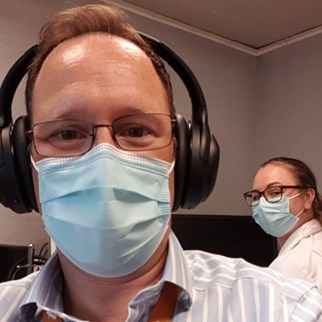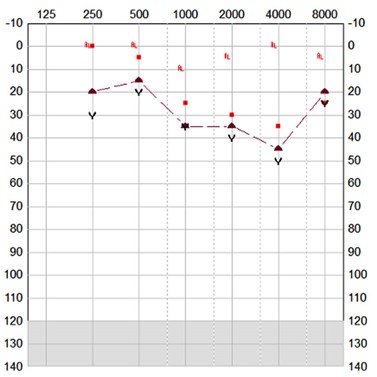
The PuroPro is the latest product from Puro Sound Labs, a family-run business focusing on high quality, sound limiting headphones. For this family business, it’s personal. The company founder’s son has a noise-induced hearing loss attributed to headphone use. With a range of award-winning headphones for children, the PuroPro enters the market aimed at adults. Puro Sound Labs put a pair into the hands of ENT & Audiology News for a technology review.
Firstly, let’s get the excitement of an unboxing out of the way. The set supplied to ENT&AN came in a wooden box, like a little treasure chest. Once you’ve opened this you find a travel case containing neatly folded Bluetooth headphones, a micro USB charging cable and a 3.5mm audio jack lead. The headphones themselves are very light and comfortable to wear. Whilst I prefer a tighter headband, there was certainly no pressure on the head from this headset and they have a soft covering over the band. Out of the box, and running music from a smartphone via Bluetooth, the sound quality felt well balanced with a good amount of bass. There is also the added bonus of an in-built microphone for calls or the hundreds of Zoom meetings we now attended daily.

Gareth Smith and Kirsten Ellis sampling the PuroPro headphones.
With the unboxing done, we go back to the raison d’etre for these devices – avoidance of noise-induced hearing loss (NIHL) due to recreational noise exposure. For an overview of the ITU_WHO guidance on safe listening limits, readers are directed to the article on Standards for Safe Listening by Masahito Kawamori, Lidia Best and Mark Laureyns.
The limits that we should be listening at are available, and many devices now have the option to limit the output of the device, or at least set a safe listening output, however this can easily be overridden.
Research also demonstrates that self-reports of listening behaviour and measured listening behaviours do not correlate [1]. Headphones with in-built limiting may help consumers make smarter choices in their daily exposure dosing. The PuroPro device offers two ways to limit daily noise exposure: ambient noise reduction and active output limiting – both crucially working together to improve a safe listening experience.
The opportunity to give ‘real world’ feedback on the noise reduction elements of the headphones is limited at the time of writing this review. Trains, planes and automobiles are rather out of favour; therefore we have turned to the clinic environment to play with the features of the headphones.

Soundfield audiogram showing the headphones under test conditions.
Passive and active noise reduction systems
To enables users to keep personal music devices output low, they need to reduce environmental noises. The PuroPro achieve this through both passive and active noise reduction. The passive reduction is achieved through over-the-ear cushions, made of protein leather. The soft cushions sit neatly around the ears and against the head. They achieved an impressive high frequency reduction when calibrated warble tones were used in a sound-treated environment through the Primus Audiometer function. On average, we recorded a 16dB reduction across the six test frequencies used. There are then two levels of active noise cancellation (ANC). For this test, we used narrowband noise for the same test frequency set. With ANC 1 we achieved an additional 13dB reduction, and with ANC 2 we achieved an additional 9dB over the passive recordings. We should acknowledge that the biggest reduction is within the low frequencies, where we would expect to see the largest reduction to dampen environmental noises such as engine/train noise. If we were able to record lower frequency levels, we would expect to record bigger levels of noise reduction.
Noise limiting
We ran probe measurement with Auditdata’s Primus system using the first author’s right ear and the PuroPro headphones. In light of Bryan Adam’s work with the Hear the World Foundation we picked Summer of ’69 for this particular task. With the volume on the phone (Samsung Galaxy 9) on full, and Spotify set to go, we ran the tune through the PuroPro whilst measuring the output through the Primus. The headphones did indeed limit the maximum output to 85dBSPL. We then pressed the +/- volume button for three seconds to override the 85dB limiter, resetting the limit to 95dB and re-ran the in-situ measurement – this gave an additional output of 10dB across the measured frequency bandwidth measured.
The PuroPro headphones are impressive both in terms of appearance and performance. I’m sure they will delight most audiophiles and provide a safe platform for listening. I will certainly be adding the children’s version of these to Master Smith’s 2020 Christmas list, and Mr Ellis is already looking to add a pair to his extensive headphone collection.
Reference
1. Kaplan-Neeman R, Muchnik C, Amir N. Listening to music with personal listening devices: monitoring the noise dose using a smartphone application. Int J Audiol 2017;56(6):400-7.





